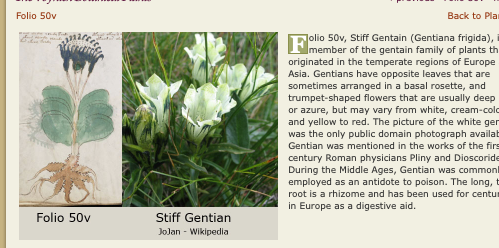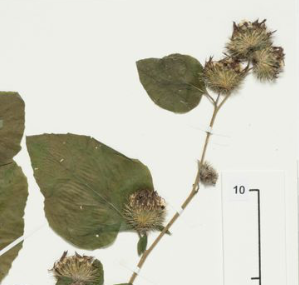27 July 2020

Plant 50v covers much of the lower portion of the folio, with 11 lines of text at the top, carefully arched to avoid writing on the flowerhead. There is a small hole in the skin just under the seedhead but the illustrator ignored it rather than incorporating it into the drawing.
The plant is drawn with a fairly thick root, with bumps along the edges. The leaves are lightly serrated or ruffled (or both) and multiple stalks end in a large rounded head with a whorl of hooks. These characteristics are common in the thistle family.
Other IDs

In 2008, Edith Sherwood identified this plant as Gentiana frigida, a small Carpathian plant that grows close to the ground. Gentian has delicate bell-like flower petals and thin hair-like roots. The leaves are narrow and upright, like snowdrop leaves. I don’t think Gentian frigida‘s root, leaves, or flower are a good match for the VMS.

My best candidate for this plant drawing is Arctium (burdock) because it has seedheads with very distinctive hooks. The roots are fairly beefy and the leaves somewhat variable. The only part that doesn’t seem to fit is the bumps on the root. Arctium minus leaves are sometimes rounder and less ruffled than Arctium lappa but leaf shape can be quite variable. The leaves tend to be more rounded when the plant is young. It’s not a perfect match, but it’s much closer to the VMS drawing than Gentiana frigida.
Arctium minus is native to Eurasia but has naturalized in North America. The stalks are sometimes green, sometimes reddish. The shoots and roots are eaten.
Arctium Seedheads
I think the VMS “flower” is probably a seedhead, with hooks at the tips.
Before Arctium seeds are fully ripe, there is a rounded yellowish center nested within a ring of projecting hooks, a characteristic that is well represented in the VMS drawing. The hooks are quite substantial. They will stick to your fingers or clothing, a dispersion strategy used by the plant to spread its seeds when wildlife wanders by. You can think of it as the Velcro® plant. Alex Hyde has captured an excellent macro-lens photo of the hooks here.
Sometimes several seedheads are at the end of a single stalk. They don’t grow together as in the VMS drawing, but perhaps this is a stylized diagram that says, “There may be several seedheads but they all look like this at the top”.
There are other plants with burred seedheads but they don’t match the VMS drawing as well.
- Agrimony has seedheads with little hooks, but the rest of the plant does not resemble Plant 50v.
- Krameria has burrs, but the leaves are small and grow in profusion along the stock, like broom.
- Xanthium (cocklebur) is similar to Arctium, but the seedheads are oblong and grow off the main stem rather than clustering on long stalks.
- Burr grass looks like a stalk of wheat except that the seeds are little star-like burs rather than oval pellets of grain so, overall, it does not match well
Except for the bumps on the roots, Arctium seems to be the best choice. It is reasonably consistent with the VMS drawing and one of the best matches for the hooks.
J.K. Petersen
© Copyright July 2013 & July 2020 J.K. Petersen, All Rights Reserved
